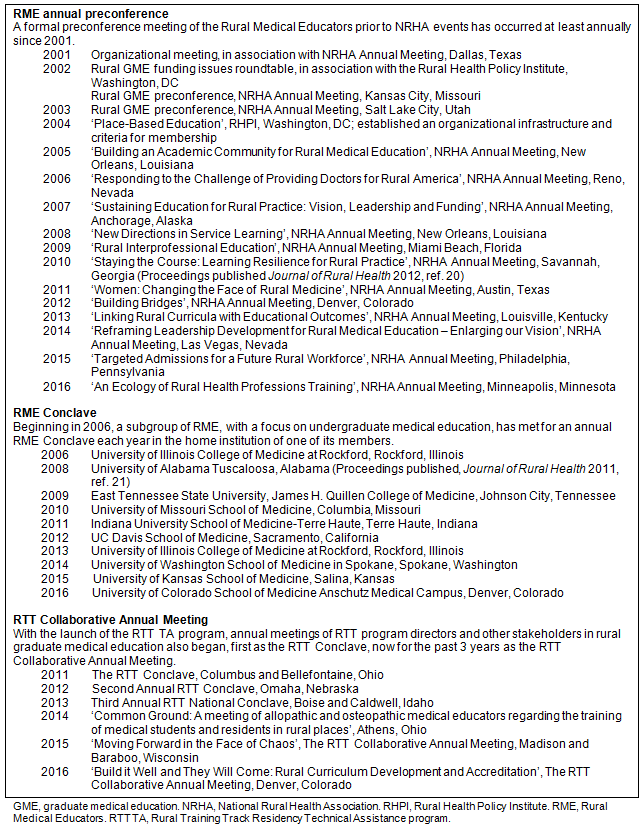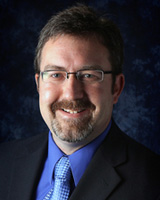This rural health history chronicles the rise, decline, and recent resurgence of rural training track residency programs (RTTs) in the USA and the emergence of a healthy community of practice in rural medical education. As summarized in the 'Lessons learned' section, that community now spans both undergraduate and graduate medical education and is poised to expand into other rural health professions.
Described by Wenger a quarter century ago1-3, communities of practice represent an informal or organized learning community or space in which members:
- interact with each other in many ways, which Wenger refers to as mutual engagement
- have a common endeavor, referred to as a joint enterprise
- develop a shared repertoire of common resources of language, styles and routines by means of which they express their identities as members of the group.
In the USA, the Society of Teachers of Family Medicine's Group on Rural Health, the National Rural Health Association's Rural Medical Educators (RME), the RTT Technical Assistance Consortium, and the RTT Collaborative in the aggregate represent an evolving community of practice in rural medical education. Membership is variously defined and individuals within each of these groups often participate in more than one organization. This article describes the evolution of this community during a time in the USA when federal and state funding of graduate medical education has been relatively stagnant and the rules around finance and accreditation of rural programs have been challenging4,5.
Although not all rural communities are underserved with regard to healthcare services, many of them are. Rural populations in general continue to face many barriers to access in comparison to their urban counterparts, and one of those barriers is the lack of an adequate physician workforce. In spite of efforts by medical educators and significant growth in medical schools and residency programs, these shortages persist6-8.
Many early family medicine residency programs developed in the USA in the 1970s included a curricular focus on rural practice, and many of the early faculty left rural communities to join urban programs and academic departments. However, by the 1980s, these curricular elements had diminished and these programs were not yet producing the numbers of rural physicians that they had hoped to achieve. In response, in 1986, Maudlin and others at the family medicine residency in Spokane developed the first 1-2 RTT in Colville, Washington9,10. A prototypical 1-2 RTT is a separately accredited residency program in which trainees upon graduation from medical school spend the first year of residency in a larger and more urban parent institution, and then 2 years in a smaller, more rural community. The intent of this strategy, based upon evidence of the effectiveness of place-based education, is to maximize the time spent by trainees in a rural community of need, while at the same time capitalizing on the teaching capacity and resources of a larger program11,12.
As in rural clinical practice, where physicians have often functioned in relative isolation from their peers and urban colleagues, rural medical educators in the 1990s and early 2000s largely practiced in isolation. In addition, rural champions in urban academic centers have frequently been the only individuals in their institution with a particular rural passion and a substantial time commitment to rural medical education. So RTTs, as independently initiated and relatively small appendages of more urban medical school and/or hospital sponsored residency programs, functioned for years in isolation from each other.
Government agencies, accrediting bodies, and academic sponsoring institutions have traditionally considered the expertise around rural graduate medical education program design and sustainability to reside primarily in experts from larger, mostly urban, academic centers, not in a shared community. Soon after the implementation of the first 1-2 RTT, however, this limited view of expertise began to change. Designing and sustaining a 1-2 RTT requires an approach somewhat different than for urban programs. It requires negotiated affiliations among multiple stakeholders over distance, and promotes collaboration rather than control by any one party, in other words a scholarship of engagement13-15. A seminal publication by four program director authors in 1992 set a more distributed pattern of expertise highlighting the uniqueness of RTTs, their common challenges as well as their variability from place to place9. Proceedings of national meetings of rural medical educators in 1990 and 2000, many of them members of the Society of Teachers of Family Medicine Group on Rural Health and many of them engaged in the development of RTTs, were published in Academic Medicine and the Journal of Rural Health16,17. The 2000 meeting in San Antonio, Texas, led to the formal organization of the RME, a special interest group subsequently established within the National Rural Health Association (NRHA).
By 2000, the concept of the 1-2 RTT had become popular among rural medical educators, many of them rural champions teaching in urban academic institutions18. Early news of success led to a peak of 35 active programs that year in 14 states. Over the subsequent decade, however, these programs experienced significant hardship due to a lack of funding and a general decline in student interest in family medicine. Several struggled to adapt the rules of accreditation developed in the context of much larger programs to the realities of rural community practice. For many of these programs, traditional graduate medical education funding from the Center for Medicare and Medicaid Services foundered or didn't materialize at all. This was an unintended consequence of federal legislative and regulatory efforts in the mid-1990s to limit the looming physician surplus predicted at that time. In spite of legislation intended to create an exception for training in rural communities (Balanced Budget Revision Act 1999), very few communities realized the intent of this legislation, largely through lack of understanding of RTTs by regulatory bodies, hospital administrators, academic institutions, and fiscal intermediaries. By 2010, only 25 programs remained19.
The plight of 1-2 RTTs did not escape notice by leaders of the Health Resources and Services Administration's Federal Office of Rural Health Policy. In 2010, in an effort to sustain the 1-2 RTT as a national strategy in training physicians for underserved rural practice, a federally funded consortium of individuals and programs established the RTT Technical Assistance program (RTT TA). The consortium named their project 'Distributed expertise: sustaining RTTs as a strategy in rural medical education'. Rather than anchoring its efforts in medical schools or hospitals, this consortium engaged as partners a wider variety of stakeholders in growing a distributed community of practice, including physician educators still living and practicing in rural communities ('local experts'), rural medical educator peers, program directors, professional groups, academic units, governmental entities such as state offices of rural health, and national associations with a stake in rural medical education.
Over the past 6 years, the consortium has succeeded in its stated objectives: (1) supporting established and newly developing RTTs, (2) increasing medical student interest in these programs, and (3) demonstrating the effectiveness of this strategy through a minimum dataset and registry of RTT trainees. From a low of 21 programs in 2012, the number has grown to 32 in 2016, accounting for a total of 68 initial residency positions propagated through each of 3 years of training. Three programs closed in the early years of the consortium, two transitioned to freestanding residency programs (ie no longer 1-2 RTTs), and one was reclassified to a '1-2 like' RTT because it had actually not been separately accredited. Since 2012, 13 new programs have opened, with at least four more slated to open in 2017. Student interest has grown and the match rate to these programs has increased, with a match rate of 82% in spite of a record number of positions offered through the national residency matches in 2016. All but two of these positions filled in the supplemental residency match. Graduate outcomes demonstrated under this project show placement rates in rural practice two to three times that of other family medicine residencies and sustained placement rates of 50% in health professions shortage areas8.
The emergence of the RME from the San Antonio meeting in 2000 and the subsequent growth of this community has occurred through annual meetings, peer consultations, email interchanges and social media, and in-person visits to rural programs and rural communities, which has resulted in several publications20,21. A formal preconference meeting of the RME prior to NRHA events has occurred at least annually since 2001 (Box 1). Beginning in 2006, a subgroup of RME, with a focus on undergraduate medical education, has met for an annual RME Conclave, in the home institution of one of its members. Then, with the launch of the RTT TA program in 2010, annual meetings of RTT program directors and other stakeholders also began, focused on rural graduate medical education and patterned on the successful interactions of the RME group and its conclave. Reciprocal peer consultations, such as an in-person visit that occurred between two RTT program directors in Colville, Washington, and Bellefontaine, Ohio, in 2010, and subsequent visits under the RTT TA program, have benefited programs and rural communities from Centreville, Alabama, to Hettinger, North Dakota; from Ramona, Oklahoma, to Glens Falls and Plattsburg, New York.
The RTT Collaborative, the non-profit that has emerged as the sustainable product of the RTT TA federal grant, is continuing this work22. An RTT Collaborative annual meeting has become critical to growing this cooperative of rural programs. The collaborative is supported financially by participation fees, contracts for direct services, and contributions from individuals and organizations. It has expanded its scope to include both allopathic and osteopathic medical student education and resident training, and eventually plans to include the training of other health professionals. A community of practice in rural health professions education and training has grown and continues to expand.

Box 1: A chronology of a rural medical education community of practice
Growing a community of practice in this fashion requires the organic building of relationships over time23. In parallel with the community-engaged approach international colleagues in Canada and Australia have taken in rural undergraduate medical education, the collaborative is now promoting a similar process, supporting both undergraduate and graduate medical education program development and sustaining these rural programs into the future24. The collaborative has developed a process and a tool, Community Engaged Residency Education in Rural Places (CERE-R, available at http://rttcollaborative.net/wp-content/uploads/2016/03/CERE-R-3-19-2016.pdf). This novel organic place-based process and tool is intended for discerning community capacity for residency education. CERE-R builds upon the assets of rural places and the distributed expertise of community members, organizations, and medical educators.
In 2015, the authors had the opportunity to develop and apply this tool in Western Montana, a state ranked 49th in 2015 for Accreditation Council for Graduate Medical Education positions per capita and facing similarly dire physician shortages in rural areas25. The CERE-R tool will continue to be refined through engagement with other communities, each unique in the resources and best strategies needed to serve its people. User feedback will be encouraged and a formal evaluation over the next 5 years will include program and workforce outcome metrics in those communities.
In summary, the Society of Teachers of Family Medicine Group on Rural Health, the NRHA RME, the RTT TA consortium, and now the RTT Collaborative, have built and nurtured a growing community of practice in rural medical education and training. They have laid a strong foundation for community-engaged rural health professions education into the future - transitioning from the usual rural penchant for 'growing your own' and the autonomy and isolation that the phrase suggests, to 'growing our own ... together'.
Disclosures and acknowledgements
Development of the CERE-R tool was funded in part by a Health Resources and Services Administration (HRSA) Residency Training in Primary Care grant #D58HP23226 and by the Federal Office of Rural Health Policy (FORHP), Health Resources and Services Administration (HRSA), U.S. Department of Health and Human Services (HHS) under cooperative agreement #1 UA9 RH 26027-01-00. The information, conclusions and opinions expressed in this report from the field are those of the authors and no endorsement by FORHP, HRSA, or HHS is intended or should be inferred.
We wish to acknowledge the community of practice and the distributed expertise of individuals and organizations who have contributed to the RTT TA program consortium and the RTT Collaborative, and in particular, the program directors of rural training tracks and other rural programs in medical school and residency education for their special contributions to the cause.
References
1. Wenger E. Communities of practice: learning, meaning and identity. New York: Cambridge University Press, 1998. https://doi.org/10.1017/CBO9780511803932
2. Barton D, Tusting K (Eds). Beyond communities of practice: language, power and social context. New York: Cambridge University Press, 2005. https://doi.org/10.1017/CBO9780511610554
3. Engeström Y. From communities of practice to mycorrhizae. In: J Hughes, N Jewson, L Unwin, (Eds). Communities of practice: critical perspectives. London: Routledge, 2007. https://doi.org/10.4324/NOE0415364737.ch4
4. Institute of Medicine. Graduate medical education that meets the nation's health needs. Washington, DC: The National Academies Press, 2014.
5. Patterson DG, Schmitz D, Longenecker R, Schmitz D, Skillman SM. Graduate medical education financing: sustaining medical education in rural places. (Internet) 2015. Available: https://www.ruralhealthinfo.org/resources/6116 (Accessed 15 March 2017).
6. Pusey WA. Medical education and medical service, I: the situation. Journal of the American Medical Association 1925; 84: 281-285. https://doi.org/10.1001/jama.1925.26620300002013
7. Rabinowitz HK, Diamond JJ, Markham FW, Hazelwood CE. A program to increase the number of family physicians in rural and underserved areas: impact after 22 years. Journal of the American Medical Association 1999; 281(3): 255-260. https://doi.org/10.1001/jama.281.3.255
8. Bolin JN, Bellamy GR, Ferdinand AO, Vuong AM, Kash BA, Schulze A, et al. Rural healthy people 2020: new decade, same challenges. Journal of Rural Health 2015; 31: 326-333. https://doi.org/10.1111/jrh.12116
9. Rosenthal TC, Maudlin RK, Sitorius M, Florence JA, Markowski G, Cleveland PD, et al. Rural training tracks in four family medicine residencies. Academic Medicine 1992; 67(10): 685-691. https://doi.org/10.1097/00001888-199210000-00014
10. 10. Maudlin RK, Newkirk GR. Family Medicine Spokane rural training track: 24 years of rural-based graduate medical education. Family Medicine 2010; 42(10): 72372-8.
11. Bowman RC, Penrod JD. Family practice residency programs and the graduation of rural family physicians. Family Medicine 1998; 30(4): 288-292.
12. Patterson DG, Schmitz D, Longenecker R, Andrilla CHA. Family medicine rural training track residencies: 2008-2015 graduate outcomes. (Internet) 2016. Available: https://www.ruralhealthinfo.org/resources/6714 (Accessed 15 March 2017).
13. Longenecker R. Curricular design: a place-based strategy for rural medical education. In: E Bell, C Zimmitat, J Merritt (Eds). Rural medical education: practical strategies. New York: Nova Science, 2011.
14. Damos JR, Sanner LA, Christman C. A process for developing a rural training track. Family Medicine 1998; 30(2): 94-99.
15. Longenecker RL. Crafting an affiliation agreement: academic-community collaboration in a rural family practice residency program. Journal of Rural Health 2000; 16(3): 237-242. https://doi.org/10.1111/j.1748-0361.2000.tb00464.x
16. Petersdorf RG (Ed.). Rural health: a challenge for medical education. Proceedings of the 1990 Invitational Symposium, San Antonio (TX), Feb 1-3, 1990. Academic Medicine 1990; 65(12 Suppl): S1-S126. https://doi.org/10.1097/00001888-199012000-00024
17. Rural-based graduate medical education: a workshop. Proceedings of a conference. February 16-18, 2000. San Antonio, Texas, USA. Journal of Rural Health 2000; 16(3): 196-306.
18. Rosenthal TC, McGuigan MH, Osborne J. One-two rural residency tracks in family practice: are they getting the job done? Family Medicine 1998; 30(2): 90-93.
19. Patterson DG, Longenecker R, Schmitz D, Skillman DM, Doescher M. Training physicians for rural practice: capitalizing on local expertise to strengthen rural primary care. (Internet) 2011. Available: https://www.ruralhealthinfo.org/resources/3537 (Accessed 15 March 2017).
20. Longenecker R, Zink T, Florence JA, Boulger JG, Hunsaker ML. Teaching and learning resilience: building adaptive capacity for rural practice. A report and subsequent analysis of a workshop conducted at the Rural Medical Educators conference, Savannah, Georgia, May 18, 2010. Journal of Rural Health 2012; 28(2): 122-127. https://doi.org/10.1111/j.1748-0361.2011.00376.x
21. Downey LH, Wheat JR, Leeper JD, et al. Undergraduate rural medical education program development: focus group consultation with the NRHA Rural Medical Educators group. Journal of Rural Health 2011; 27(2): 230-238. https://doi.org/10.1111/j.1748-0361.2010.00334.x
22. RTT Collaborative. Ohio: the RTT Collaborative. (Internet) 2016. Available: https://rttcollaborative.net/ (Accessed 15 March 2017).
23. Longenecker R. Sustaining engagement and rural scholarship. Journal of Higher Education Outreach and Engagement 2003; 8(1): 87-97.
24. Strasser R, Worley P, Cristobal F, Marsh DC, Berry S, Strasser S, et al. Putting communities in the driver's seat: the realities of community-engaged medical education. Academic Medicine 2015; 90(11): 1466-1470. https://doi.org/10.1097/ACM.0000000000000765
25. Association of American Medical Colleges. State Physician Workforce Data Book 2015. Washington DC: Association of American Medical Colleges, 2015.


